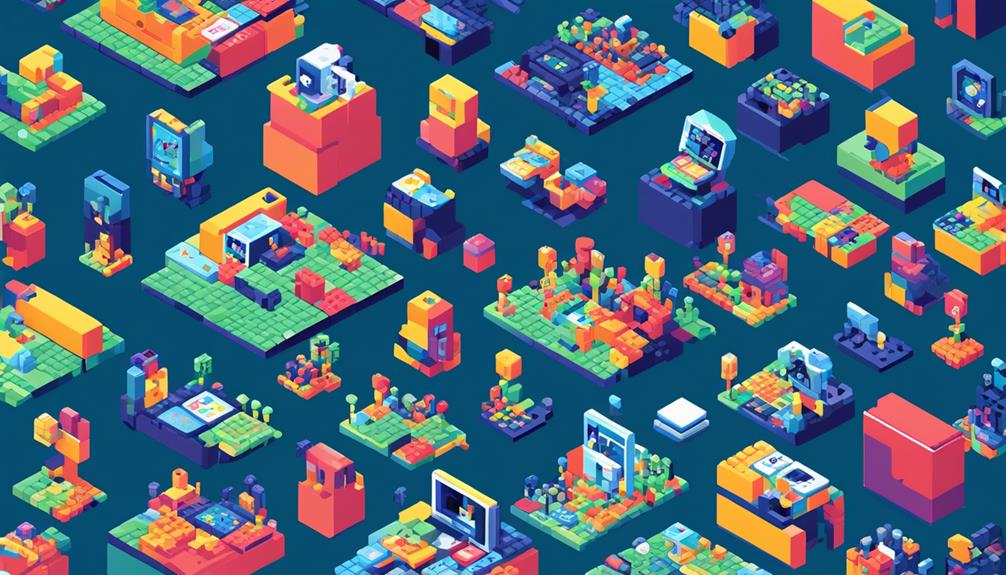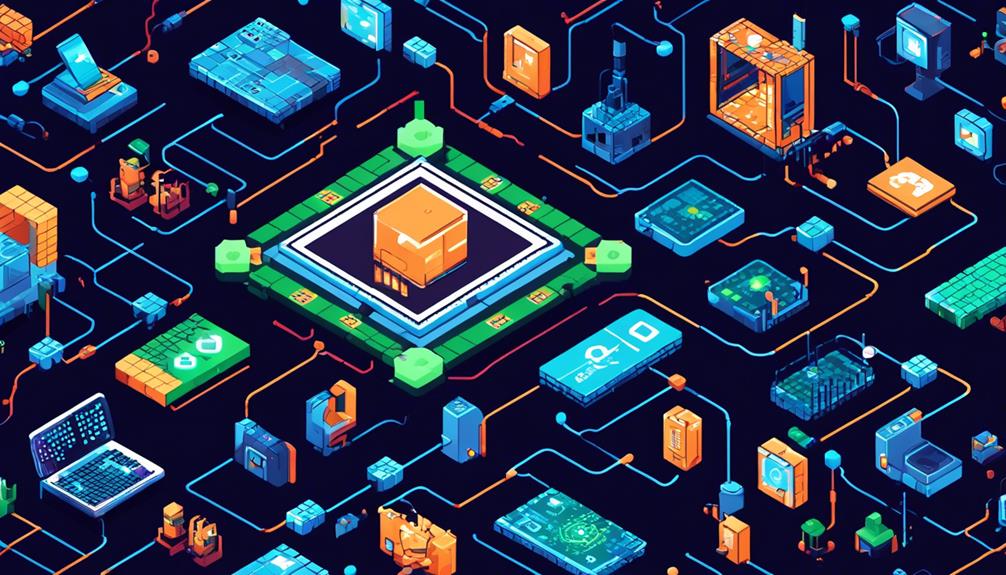The future of IoT hardware holds immense potential as advancements in technology continue to shape its trajectory. From miniaturization and compact IoT devices to enhanced power efficiency and the integration of AI and machine learning, the possibilities are vast.
Moreover, advancements in sensor technology and increased connectivity options further contribute to the growth and innovation in this field. As we delve into the discussion on the future of IoT hardware, it becomes evident that the potential applications extend beyond smart homes and cities, encompassing wearable devices, industrial automation, and monitoring.
However, what truly sets the stage for an intriguing exploration is the emergence of sustainable and eco-friendly solutions, paving the way for a greener future.
Key Takeaways
- Miniaturization and compact IoT devices are enabling the integration of IoT technology into a wide range of applications and environments.
- Enhanced power efficiency in IoT hardware is extending the lifespan of devices and reducing energy consumption.
- The integration of AI and machine learning in IoT hardware is revolutionizing data processing and analysis capabilities.
- Security advancements, including cloud-based solutions and blockchain technology, are addressing the growing concerns surrounding data security in IoT hardware.
Miniaturization and Compact Iot Devices

Miniaturization and compact designs have revolutionized the field of IoT hardware, enabling the creation of smaller, more portable devices that can seamlessly integrate into diverse environments and enhance functionality without occupying significant space. This advancement in miniaturization technology has opened up new possibilities for the development and deployment of IoT devices.
The ability to create smaller and more compact IoT devices has significant implications for their portability and versatility. These devices can be easily carried or embedded within objects or systems, expanding the range of potential applications and use cases. Whether it is a wearable device, a smart home appliance, or an industrial sensor, the compact size allows for seamless integration into various environments.
Furthermore, miniaturization and compact designs enable IoT devices to be discreetly embedded within objects or systems, enhancing their functionality without occupying significant space. This means that IoT technology can be seamlessly integrated into everyday objects, making them 'smart' and connected. For example, a compact IoT device can be embedded within a door lock, enabling remote access control and monitoring without the need for bulky and visible equipment.
In addition to their enhanced portability and discreet integration, miniaturized IoT devices also contribute to energy efficiency and resource-consciousness. The smaller size allows for the optimization of power consumption, making these devices more energy-efficient. This is crucial for IoT devices that are often battery-powered and need to operate for extended periods without requiring frequent battery replacements.
The miniaturization of IoT hardware also plays a vital role in the proliferation of IoT networks. The compact size of these devices facilitates seamless connectivity and communication across diverse ecosystems, enabling the establishment of robust IoT networks. These networks can encompass various devices and systems, enhancing the overall efficiency and effectiveness of IoT applications.
Enhanced Power Efficiency for Iot Hardware
Enhancing power efficiency is a critical aspect of optimizing battery life and reducing energy consumption in IoT hardware. As IoT devices continue to proliferate and become more integrated into our daily lives, it is imperative to develop techniques and technologies that can enhance power efficiency in these devices.
One approach to improving power efficiency in IoT hardware is the use of low-power processors and energy-efficient components. These components are designed to consume minimal power while still providing the necessary processing capabilities for IoT applications. By utilizing such components, IoT devices can operate for longer periods without draining the battery.
Another technique for enhancing power efficiency is the implementation of sleep modes and power management techniques. Sleep modes allow IoT devices to conserve power by temporarily shutting down non-essential components or reducing their power consumption when they are not actively performing tasks. Power management techniques, on the other hand, involve dynamically adjusting the power consumption of different components based on the current workload.
Energy harvesting techniques can also play a crucial role in enhancing power efficiency in IoT hardware. By utilizing sources such as solar or kinetic energy, IoT devices can generate their own power, reducing their reliance on batteries or external power sources. This not only improves power efficiency but also enables IoT devices to operate in remote or inaccessible locations.
Furthermore, efficient power management algorithms and protocols are necessary for optimizing power consumption in IoT hardware. These algorithms and protocols ensure that power is allocated efficiently among different components and tasks, minimizing unnecessary power consumption.
Integration of AI and Machine Learning in Iot Hardware

As the power efficiency of IoT hardware continues to be optimized, the integration of AI and machine learning emerges as a pivotal advancement in enhancing the capabilities and intelligence of these devices. Leveraging AI and machine learning in IoT hardware enables intelligent decision-making and automation in various IoT applications.
Here are some key developments in this field:
- AI-powered analytics: The integration of AI and machine learning in IoT hardware allows for the extraction of actionable insights from IoT data. By using AI algorithms, IoT devices can enhance predictive maintenance and fault detection. These intelligent devices can analyze large volumes of data in real-time, identifying patterns and anomalies that human operators may overlook.
- Generative AI augmentation: IoT devices can be augmented with generative AI to provide personalized experiences. For example, smartwatches and fitness trackers can act as personal assistants or fitness coaches, tailoring recommendations based on an individual's specific needs and goals. Generative AI can also be used to create realistic virtual environments for training and simulation in IoT applications.
- Natural language processing integration: The convergence of IoT technology with AI and machine learning enables the integration of natural language processing. This integration allows for voice-activated IoT devices, enhancing the user experience through AI-driven personalization. Users can interact with their IoT devices using voice commands, making the interaction more intuitive and seamless.
The integration of AI and machine learning in IoT hardware is revolutionizing the capabilities of these devices. From intelligent analytics to personalized experiences and voice-activated interactions, AI is transforming the way IoT devices operate. As AI and machine learning algorithms continue to improve, we can expect even more sophisticated and intelligent IoT hardware in the future.
Advancements in Sensor Technology for Iot Devices
Advancements in sensor technology have significantly improved the precision and efficiency of data collection in IoT devices. These advancements are enabling IoT sensors to gather data more accurately and reliably, leading to enhanced performance and functionality of IoT devices.
One major advancement in sensor technology for IoT devices is the development of smaller and more energy-efficient sensors. These miniaturized sensors are designed to consume less power while still providing accurate data collection. As a result, IoT devices can now operate for longer periods without needing frequent battery replacements or recharging.
Furthermore, new sensor technologies are expanding the range of measurements that IoT devices can perform. Environmental sensors, for example, can now measure factors like temperature, humidity, air quality, and noise levels with higher accuracy. Biometric sensors are also evolving to capture data such as heart rate, blood pressure, and even emotional states, enabling IoT devices to monitor and respond to human health and well-being.
The integration of artificial intelligence (AI) and machine learning (ML) techniques is further enhancing the capabilities of sensor technology in IoT devices. AI algorithms can analyze sensor data in real-time, allowing IoT devices to make intelligent decisions and take appropriate actions based on the collected information. ML algorithms can also learn from the sensor data over time, improving the accuracy and reliability of future data collection.
Increased Connectivity Options for Iot Hardware

The future of IoT hardware lies in the realm of increased connectivity options, offering a seamless integration with various networks and devices.
Wireless connection advancements are enabling IoT devices to connect and communicate efficiently, while the expansion of communication protocols such as 5G, edge computing, and AI-powered protocols are paving the way for enhanced device compatibility.
With these advancements, IoT hardware can operate in challenging environments and remote locations, expanding its capabilities for diverse applications.
Wireless Connection Advancements
Wireless connectivity options for IoT hardware have significantly expanded due to advancements in wireless communication protocols. This has led to several improvements in the field of IoT hardware, including increased connectivity options and enhanced communication capabilities.
Here are some key advancements in wireless connection options for IoT hardware:
- Improved wireless communication protocols: IoT devices are now equipped with more advanced protocols, such as Bluetooth Low Energy (BLE), Zigbee, and Z-Wave, which provide better range, lower power consumption, and increased data transfer rates.
- Longer distance communication: The development of new wireless technologies, such as LoRaWAN and NB-IoT, enables IoT devices to communicate over longer distances, making them suitable for applications that require wide-area coverage.
- Enhanced security and reliability: The advancements in wireless connections have also resulted in more reliable and secure connections for IoT devices. Encryption techniques and authentication protocols ensure data privacy and prevent unauthorized access.
These wireless connection advancements are driving the seamless integration and communication among various IoT devices, paving the way for a more connected and efficient future.
Expansion of Communication Protocols
With the increasing expansion of communication protocols, IoT hardware is now able to achieve a higher level of connectivity options, allowing for seamless integration and interaction with a diverse range of systems and platforms.
The growth in the variety of communication protocols has greatly enhanced the interoperability and versatility of IoT technology. New communication protocols enable IoT devices to connect and interact with a wider range of systems and platforms, resulting in enhanced connectivity and data exchange capabilities.
This expansion of communication protocols has opened up new possibilities for IoT hardware, enabling it to integrate seamlessly into diverse environments and networks. The increased connectivity options provided by these protocols have significantly improved the ability of IoT hardware to communicate and exchange data with a broader spectrum of devices and services, further driving the growth and potential of IoT technology.
Enhanced Device Compatibility
Enhanced device compatibility revolutionizes the connectivity options available for IoT hardware, facilitating seamless integration with a wide array of devices and platforms. This increased compatibility opens up a range of possibilities for IoT devices, allowing them to connect and communicate with various systems and protocols.
Here are three key benefits of enhanced device compatibility:
- Versatility: IoT devices can now be compatible with various communication technologies such as Wi-Fi, Bluetooth, Zigbee, and LoRaWAN. This enhances their versatility and enables them to adapt to different networking environments.
- Interoperability: With enhanced device compatibility, IoT hardware can work cohesively with devices and ecosystems from different manufacturers. This fosters interoperability and simplifies the integration process.
- Scalability and Flexibility: The expansion of connectivity options in IoT hardware enables more flexible and scalable deployment across various environments and use cases. This means that IoT devices can easily adapt to new technologies and scale up as needed.
Security Advancements in Iot Hardware

Security advancements in IoT hardware are essential to protect against cyber attacks and ensure the privacy of personal data collected by these devices. The increasing number of connected devices in the IoT ecosystem has expanded the attack surface, making robust security measures a necessity. With the potential for widespread data breaches and unauthorized access, the future of IoT depends on implementing effective security solutions.
To address the security challenges, regulations and standards are being developed to establish guidelines for IoT security and privacy. These initiatives emphasize the importance of security advancements in IoT hardware. By adhering to these regulations, manufacturers can ensure that their devices meet minimum security requirements and protect user data.
One crucial aspect of IoT security is the implementation of encryption and authentication protocols. Encrypting data transmitted between IoT devices and cloud platforms ensures the confidentiality and integrity of the information. Additionally, strong authentication mechanisms, such as two-factor authentication or biometrics, help verify the identity of users and prevent unauthorized access.
Furthermore, continuous monitoring and vulnerability management are essential for maintaining the security of IoT devices. Regular security updates and patches are crucial to address newly discovered vulnerabilities and protect against emerging threats.
As the future of IoT unfolds, security advancements in hardware must keep pace with the evolving threat landscape. This includes integrating security features directly into IoT devices, enabling secure booting, secure firmware updates, and secure storage of sensitive data. By prioritizing security, IoT hardware can provide users with the confidence that their personal information is protected, ultimately driving the widespread adoption and success of IoT technologies.
Cloud-Based Iot Hardware Solutions
Cloud-based IoT hardware solutions offer a range of benefits, including scalability and data security. The scalability of these solutions allows for easy expansion and adaptation to meet changing needs, ensuring that IoT deployments can grow alongside the business.
Additionally, data security is a critical aspect of cloud-based IoT hardware solutions, as they provide robust measures to protect sensitive information and ensure compliance with industry regulations.
Scalability of Cloud-Based Iot
The scalability of hardware solutions in cloud-based IoT enables seamless expansion of connected devices and efficient processing of increasing data volumes. Here are some key points about the scalability of cloud-based IoT hardware:
- Cloud-based IoT solutions have the capability to accommodate a large number of connected devices and handle the growing data volumes generated by these devices.
- Scalability allows cloud-based IoT platforms to adapt to changing business needs and support growing demands.
- Cloud-based IoT hardware solutions can scale horizontally by adding more devices, allowing for the expansion of IoT deployments.
- Vertical scalability is also possible, where cloud-based IoT platforms can increase processing power and storage to handle larger amounts of data.
- The scalability of cloud-based IoT hardware ensures flexibility and efficiency in managing diverse IoT deployments, providing businesses with the ability to scale their IoT infrastructure as needed.
Data Security in Cloud-Based Iot
With the increasing number of connected devices and the growing data volumes in cloud-based IoT hardware solutions, ensuring data security becomes a paramount concern for businesses.
Cloud-based IoT hardware solutions employ various data security measures to protect against potential cyber attacks and privacy breaches. Encryption and authentication mechanisms play a crucial role in ensuring data security in cloud-based IoT environments. However, the large number of connected devices in cloud-based IoT solutions expands the attack surface, necessitating robust security measures.
Privacy concerns related to the collection of personal data by IoT devices are addressed through secure cloud-based solutions. As a result, regulations and standards are continuously evolving to address data security and privacy challenges in cloud-based IoT hardware.
Businesses must prioritize data security to safeguard sensitive information and maintain the trust of their customers.
Blockchain Technology in Iot Hardware

Blockchain technology revolutionizes the security and decentralization of IoT hardware networks, ensuring the integrity and immutability of data transmitted between interconnected devices. By incorporating blockchain technology into IoT hardware, several benefits can be achieved:
- Secure and Transparent Transactions: Blockchain technology enables secure and transparent transactions and interactions between IoT devices. Each transaction is recorded on a distributed ledger, ensuring transparency and reducing the risk of fraud or manipulation.
- Risk Mitigation: The adoption of blockchain technology in IoT hardware mitigates the risk of unauthorized access and tampering of IoT data and transactions. The decentralized nature of blockchain ensures that data is stored across multiple nodes, making it difficult for hackers to compromise the system.
- Enhanced Trust, Security, and Privacy: The integration of blockchain technology in IoT hardware enhances trust, security, and privacy for interconnected devices. With blockchain, IoT devices can securely authenticate and communicate with each other, reducing the vulnerability to cyberattacks and ensuring the privacy of sensitive data.
Edge Computing for Faster and Efficient Iot Operations
Edge computing is a transformative technology that enables faster and more efficient operations for IoT devices by processing data in close proximity to the source. Traditional IoT architectures often rely on transmitting data to the cloud for processing, which can introduce latency and pose challenges in terms of network bandwidth and reliability. With edge computing, the processing of data is shifted closer to the devices themselves, allowing for real-time insights and reduced reliance on cloud infrastructure.
By processing data at the edge, IoT devices can quickly analyze and respond to data in near real-time, without the need to transmit large amounts of raw data to the cloud. This not only reduces latency but also improves network efficiency by reducing the amount of data that needs to be transmitted. Additionally, edge computing allows for more autonomous and intelligent devices, as it enables AI integration at the edge. This means that the devices themselves can make intelligent decisions and take actions without relying on constant communication with the cloud.
The emergence of 5G networks plays a pivotal role in making edge computing a viable solution for new IoT applications. 5G provides faster and more reliable connectivity, which is essential for real-time data processing at the edge. This is particularly beneficial for IoT devices such as autonomous vehicles, where split-second decision-making based on real-time data is crucial for safe and efficient operations.
Iot Hardware for Smart Homes and Cities

When it comes to IoT hardware for smart homes, connectivity is a key point that needs to be addressed. The ability to connect various devices seamlessly and securely is crucial for effective home automation.
Additionally, integrating IoT hardware into urban infrastructure is essential for creating smart cities. This integration can improve the efficiency of energy management, traffic control, and environmental monitoring.
Lastly, robust security measures are imperative to protect against cyber threats and maintain privacy in both smart homes and cities.
Smart Home Connectivity
Smart home connectivity, an essential component of IoT hardware for smart homes and cities, enables seamless communication and integration among various interconnected devices within a home or urban environment. This connectivity allows for the efficient control and monitoring of smart devices, enhancing convenience and functionality for homeowners and city dwellers.
Some key aspects of smart home connectivity include:
- Interconnected Devices: IoT hardware for smart homes and cities encompasses a range of devices, such as smart thermostats, lighting systems, security cameras, and voice assistants. These devices can communicate with each other, creating a unified and cohesive smart home experience.
- Remote Control: With smart home connectivity, users can remotely control and manage their devices through a central hub or smartphone app. This allows for easy access and control, even when away from home.
- Enhanced Efficiency and Security: Smart home connectivity promotes energy efficiency by optimizing the use of resources and enabling automation. Additionally, it enhances security through features like remote monitoring and alerts, providing peace of mind for homeowners.
The integration of IoT hardware and smart home connectivity is revolutionizing the way we live, offering a more interconnected and automated living experience.
Urban Infrastructure Integration
The integration of IoT hardware into urban infrastructure plays a crucial role in creating interconnected and efficient living spaces for smart homes and cities. Urban areas are constantly evolving, and the integration of IoT devices allows for the optimization of various urban systems.
These systems include transportation, energy, and waste management, among others. By deploying IoT sensors and devices throughout urban infrastructure, data can be collected and analyzed to enable automated control and decision-making. This data-driven approach enhances resource usage and improves the quality of life for residents in smart cities.
The integration of IoT hardware into urban infrastructure enables the creation of connected and efficient living spaces, paving the way for the future of smart cities.
Iot Security Measures
With the integration of IoT hardware into urban infrastructure paving the way for interconnected and efficient living spaces, the next critical subtopic to address is the implementation of robust security measures to safeguard IoT devices in smart homes and cities.
- Implement robust encryption and authentication mechanisms: To protect IoT devices from potential cyber attacks, it is crucial to employ strong encryption algorithms and authentication protocols. This ensures that only authorized devices can access and communicate with IoT devices, minimizing the risk of unauthorized access.
- Develop standardized security protocols and regulations: Privacy concerns are a significant issue in IoT devices. By establishing standardized security protocols and regulations, it becomes possible to address these concerns and protect the data collected by IoT devices. This includes data encryption, user consent, and secure data storage practices.
- Integrate AI and machine learning for enhanced security: AI and machine learning can play a vital role in detecting and mitigating potential security threats in real-time. By integrating these technologies with IoT devices, it becomes possible to identify anomalies and patterns that indicate a breach or attack, enabling prompt action to be taken.
Wearable Iot Devices and Smart Accessories

Wearable IoT devices and smart accessories, equipped with sensors and connectivity, revolutionize data tracking and communication by seamlessly integrating AI, machine learning, and real-time data processing. These devices, such as smartwatches, fitness trackers, smart clothing, and augmented reality glasses, are designed to be worn on the body, providing personalized experiences and real-time data monitoring.
By combining IoT technology with wearables, these devices offer a range of functionalities and applications. They often incorporate generative AI, acting as personal assistants, fitness coaches, or enhancing their capabilities to provide a more immersive and interactive user experience. With their ability to track and analyze data in real-time, wearable IoT devices can provide actionable insights and improve user experiences in various industries, including healthcare, fitness, and personal productivity.
To visually represent the impact of wearable IoT devices and smart accessories, below is a table showcasing their key features:
| Device | Key Features |
|---|---|
| Smartwatches | Real-time notifications and health tracking |
| Fitness Trackers | Step counting, heart rate monitoring, sleep tracking |
| Smart Clothing | Biometric sensors for activity tracking and posture correction |
| Augmented Reality Glasses | Overlay of digital information onto the physical world |
| Personal Assistants | Voice-controlled AI for tasks and reminders |
These devices enable individuals to seamlessly integrate technology into their daily lives, enhancing their overall well-being and productivity. With advancements in IoT technology, wearable IoT devices and smart accessories will continue to evolve, offering even more innovative features and applications in the future.
Iot Hardware for Industrial Automation and Monitoring
IoT hardware for industrial automation and monitoring involves the use of specialized devices and sensors designed to withstand harsh industrial environments and provide real-time data for efficient automation. Industrial IoT hardware includes industrial-grade sensors, actuators, controllers, and communication modules for seamless integration into industrial systems. These devices play a crucial role in improving operational efficiency, reducing downtime, and enhancing overall productivity in industrial automation and monitoring applications.
Here are some key aspects of IoT hardware for industrial automation and monitoring:
- Robust Design: Industrial IoT hardware is built to withstand extreme temperatures, humidity, vibrations, and other challenging conditions commonly found in industrial settings. This ensures reliable operation and longevity of the devices, minimizing the need for frequent maintenance or replacements.
- Real-time Data Acquisition: Industrial IoT devices are equipped with sensors that capture various types of data, such as temperature, pressure, flow rates, and energy consumption. This real-time data provides valuable insights into the performance of industrial processes, enabling operators to make informed decisions and optimize operations.
- Integration Capabilities: IoT hardware for industrial automation is designed to seamlessly integrate with existing industrial systems and infrastructure. This allows for the easy incorporation of automation and monitoring capabilities into the existing workflows without disrupting the entire operation.
Sustainable and Eco-Friendly Iot Hardware Solutions

Sustainable and eco-friendly IoT hardware solutions have emerged as a critical focus in the development and implementation of Internet of Things (IoT) technologies. These solutions prioritize energy efficiency and minimal environmental impact, aiming to reduce electronic waste and promote recyclable materials in IoT device manufacturing. By incorporating sustainable and eco-friendly practices, businesses can contribute to environmental conservation and reduce their ecological footprint.
One key aspect of sustainable IoT hardware solutions is energy efficiency. These devices are designed to consume minimal power while still providing optimal performance. By reducing energy consumption, they not only minimize their impact on the environment but also help lower operating costs for businesses. Renewable energy sources, such as solar or wind power, are also employed to power IoT devices, further reducing carbon emissions.
In addition to energy efficiency, sustainable IoT hardware solutions focus on using biodegradable and recyclable materials in their manufacturing processes. These materials minimize the environmental impact at the end of the device's lifecycle. By using environmentally friendly materials, businesses can contribute to reducing electronic waste and promote the circular economy.
Furthermore, eco-conscious design practices are integrated into the development of sustainable IoT hardware. These practices emphasize the usability, repairability, and upgradeability of devices, extending their lifespan and reducing the need for frequent replacements. Additionally, devices are designed with end-of-life considerations in mind, making it easier to disassemble and recycle components.
Frequently Asked Questions
What Is the Future of Iot Technology?
The future of IoT technology is promising and transformative. With the increasing role of artificial intelligence in IoT, devices will become more intelligent and autonomous, enabling efficient decision-making and data sharing.
However, implementing IoT technology comes with challenges such as security risks and privacy concerns. To address these challenges, robust cybersecurity measures and privacy regulations need to be in place.
What Is the Future of Iot in 2024?
In 2024, the future of IoT is expected to witness significant advancements in data security and IoT infrastructure. As AI-powered cyber-attacks continue to pose a threat, ensuring the security of IoT devices will be crucial for remote workforces.
Additionally, the integration of edge computing, AI, and 5G networks will enable quicker insights and smarter devices. The convergence of IoT technology with AI and machine learning will also contribute to the development of intelligent devices and gadgets in various sectors, including healthcare.
What Is the Forecast for Iot Devices?
The forecast for IoT devices indicates significant growth in the market. With the increasing adoption of IoT technology across various industries, the number and diversity of IoT devices are expected to rise.
However, this growth also brings security challenges. To address this, the development of advanced security measures and standards for IoT devices is crucial. Ensuring the security of IoT devices will be essential to mitigate the risks associated with cyber attacks and privacy breaches.
What Is the Iot Prediction for 2025?
In 2025, the Internet of Things (IoT) is predicted to undergo significant advancements in terms of security and healthcare applications. With the increasing threat of AI-powered cyber-attacks, IoT security measures will become more robust and sophisticated.
In healthcare, the IoT market is expected to reach $289 billion, with virtual hospitals playing a crucial role in managing the needs of an aging population. These developments highlight the growing importance of IoT in ensuring secure and efficient healthcare delivery.
